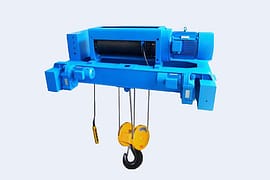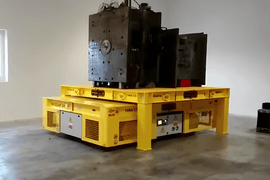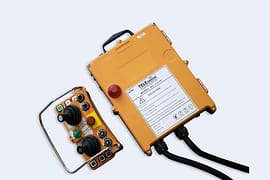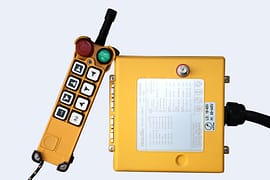The Most Comprehensive Introduction to China’s Crane and Its Accessories Nameplates : A Novice’s Guide
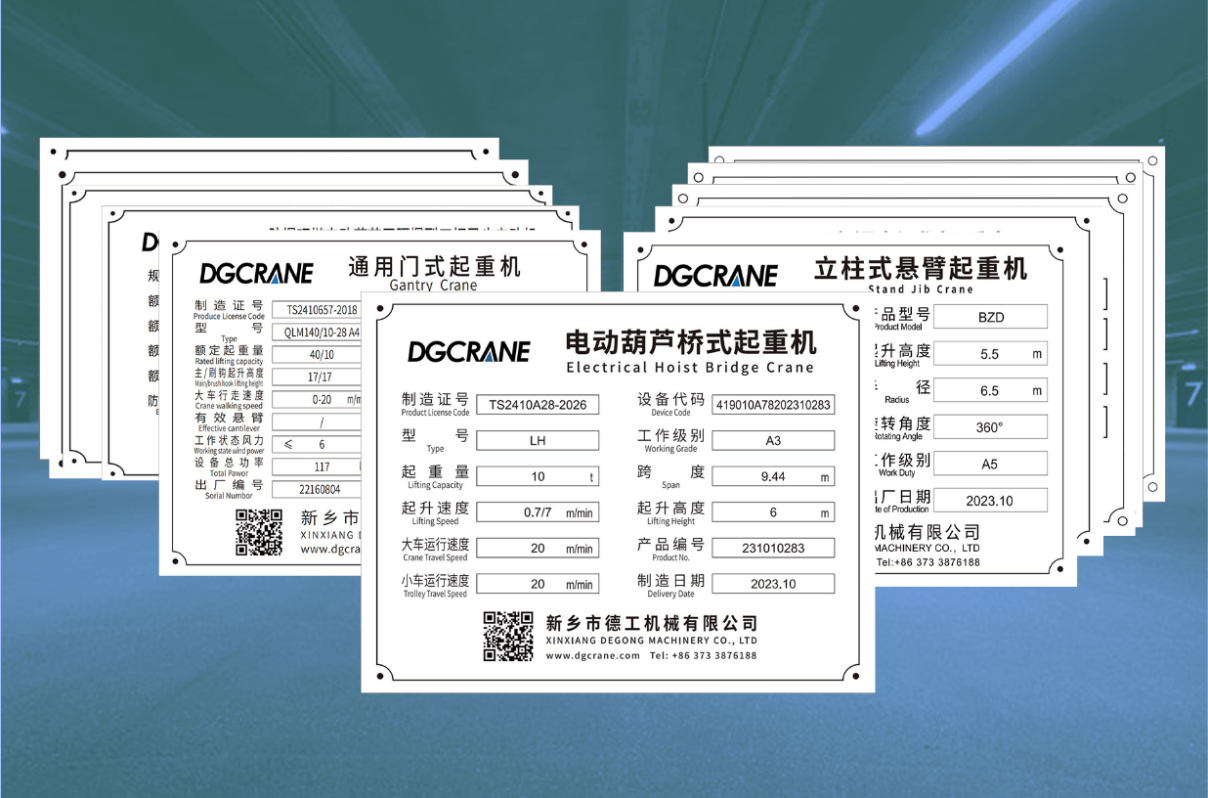
This article provides a comprehensive introduction to the nameplates of cranes and various related components produced in China. It guides you through the different parameters included on the nameplates of various products, as well as the basic crane knowledge and crane terminology, helping you easily understand product information.
Cranes:
General Bridge Cranes
Explosion-Proof Overhead Cranes
General Gantry Cranes
Jib Cranes
Crane Components:
Crane Trolleys
Crane Hoists
Explosion-Proof Hoists
Winches
Crane Control Cabinets
Three-Phase Induction Motors
Explosion-Proof Three-Phase Induction Motors
Crane Cable Reels
Crane Drums
Crane Rail Clamps
Crane Hooks
Crane Reducers
Crane Brakes
Crane Load Limiters
General Bridge Crane Nameplate
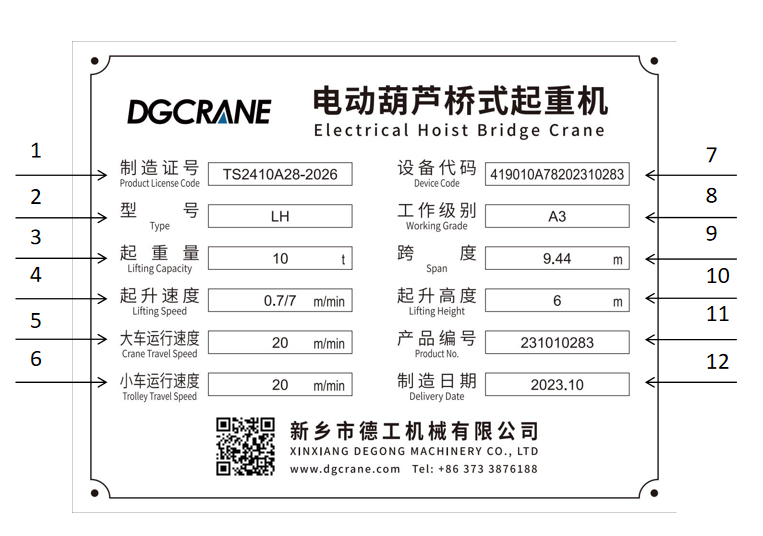
1. Product License Code:
As eot cranes are special equipment, they require a corresponding Product license to be produced. Each manufacturer has a different Product License Code.
2. Type:
Different models of cranes have their respective type codes.
3. Lifting Capacity:
The rated lifting capacity Q is the maximum weight allowed to be lifted in a single operation under normal working conditions of the crane, measured in tons (t) or kilograms (kg).
Notes on rated lifting capacity:
A. The rated lifting capacity of a hook crane does not include the weight of the hook and the moving pulley group.
B. The weight of removable material handling devices like grabs, electromagnetic suction cups, balancing beams, etc., should be included in the rated lifting capacity.
4. Lifting Speed:
Refers to the vertical displacement speed of the rated load under stable operating conditions of the bridge crane, measured in meters per minute (m/min).
For example, a single girder overhead crane with 0.7/7m/min on its nameplate has two lifting speeds: a fast speed of 7m/min and a slow speed of 0.7m/min.
5. Crane Travel Speed:
Refers to the travel speed of the crane on a horizontal surface or track when fully loaded, measured in meters per minute (m/min).
6. Trolley Travel Speed:
The travel speed of the trolley on horizontal tracks under stable motion conditions with the rated load, measured in meters per minute (m/min).
7. Device Code:
Composed of three parameters: product category code, manufacturer’s number, and product number.
8. Working Grade:
The overall working class of the crane ranges from A1 to A8 (A1 < A8). The working class of a crane is determined by two factors: the frequency of use, known as the crane utilization class, and the size of the load it bears, known as the load state of the crane.
9. Span:
The horizontal distance between the centerlines of the crane’s main girder running tracks, measured in meters (m), denoted as S.
10. Lifting Height:
The distance from the ground or the top surface of the track to the highest lifting position of the material handling device (the center of the hook for hooks, the lowest point for grabs, other containers, and electromagnetic suction cups), marked as H. If the lifting device can descend below ground level, the depth below ground is referred to as the descending depth (h).
11. Product Number:
Unique number assigned by the manufacturer when the crane leaves the factory. The manufacturer can use this number to access all information about the product.
12. Delivery Date
Explosion-Proof Overhead Crane Nameplate
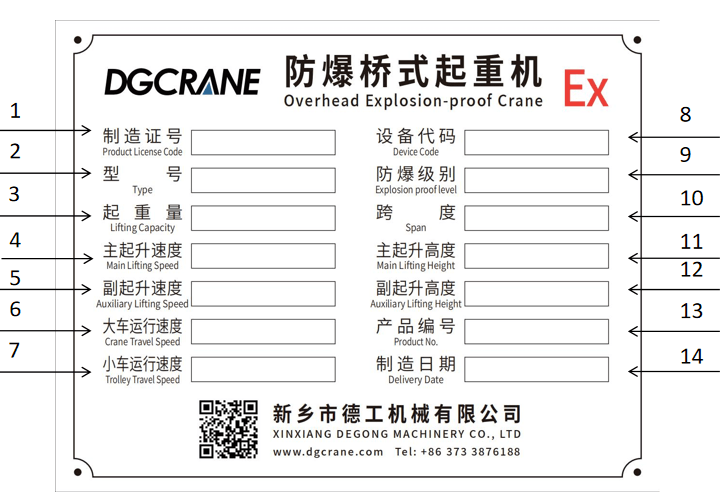
1. Product License Code:
Explosion-proof bridge cranes are classified as special equipment and require a corresponding Product license for production. Each manufacturer has a distinct Product License Code.
2. Type:
Composed of three parameters: product category code, manufacturer’s number, and product number. Different models of cranes have their respective model codes.
3.Lifting Capacity:
The rated lifting capacity Q, which is the maximum weight that the crane is allowed to lift in a single operation under normal working conditions, measured in tons (t) or kilograms (kg).
Notes on rated lifting capacity:
A. The rated lifting capacity of a hook crane does not include the weight of the hook and the moving pulley group.
B. The weight of removable material handling devices like grabs, electromagnetic suction cups, balancing beams, etc., should be included in the rated lifting capacity.
Example: 100/20t indicates that the eot crane has two lifting devices; the main crane hook can lift 100t and the auxiliary crane hook 20t. Thus, the total lifting capacity of the eot crane is the same as the main crane hook, 100t.
4. Main Lifting Speed:
Refers to the vertical displacement speed of the rated load on the main crane hook under stable operating conditions, measured in meters per minute (m/min).
5. Auxiliary Lifting Speed:
Refers to the vertical displacement speed of the rated load on the auxiliary crane hook under stable operating conditions, measured in meters per minute (m/min).
6. Crane Travel Speed:
Refers to the travel speed of the bridge crane on a horizontal surface or track when fully loaded, measured in meters per minute (m/min).
7. Trolley Travel Speed:
The travel speed of the trolley on horizontal tracks under stable motion conditions with the rated load, measured in meters per minute (m/min).
8. Device Code:
Composed of three parameters: product category code, manufacturer’s number, and product number.
9. Explosion-Proof Level:
The explosion-proof level describes the explosion protection capabilities of various components of explosion-proof overhead cranes. Common explosion proof symbol include ExdIIBT4, ExdIICT4, etc. ‘Ex’ signifies an explosion-proof crane, ‘d’ indicates that the crane is flameproof, ‘IIB’ or ‘IIC’ denotes the explosion-proof grade in explosive gas atmospheres, and ‘T4’ represents the maximum working temperature.
10. Span:
The horizontal distance between the centerlines of the crane’s main girder running tracks, measured in meters (m), denoted as S.
11. Main Lifting Height:
The distance from the ground or track surface to the highest lifting position of the main crane hook (the center of the hook for hooks, the lowest point for grabs, other containers, and electromagnetic suction cups), marked as H.
12. Auxiliary Lifting Height:
The distance from the ground or track surface to the highest lifting position of the auxiliary hook (the center of the hook for hooks, the lowest point for grabs, other containers, and electromagnetic suction cups), marked as H.
13. Product Number:
Unique number assigned by the manufacturer when the bridge crane leaves the factory. The manufacturer can use this number to access all information about the product.
14. Delivery Date
General Gantry Crane Nameplate
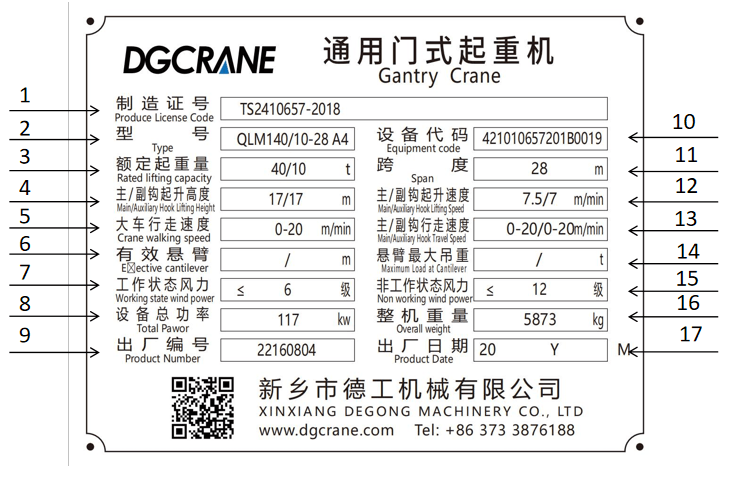
1. Product License Code:
Gantry cranes are classified as special equipment and require a corresponding manufacturing license to be produced. Each manufacturer has a distinct Product License Code.
2. Type:
The model of a gantry crane is typically composed of four parameters: product identification number, rated lifting capacity, span, and working class.
3. Rated Lifting Capacity:
The rated lifting capacity Q is the maximum weight that the gantry crane is allowed to lift in a single operation under normal working conditions, measured in tons (t) or kilograms (kg).
Notes on rated lifting capacity:
A. The rated lifting capacity of a hook crane does not include the weight of the hook and the moving pulley group.
B. The weight of removable material handling devices like grabs, electromagnetic suction cups, balancing beams, etc., should be included in the rated lifting capacity.
For example, the nameplate with 40/10t indicates the crane has two lifting devices; the main hook can lift 40t and the auxiliary hook 10t. Thus, the total rated lifting capacity of the crane is the same as the main hook, 40t.
4. Main/Auxiliary Hook Lifting Height:
The distance from the ground or track surface to the highest lifting position of the main/auxiliary crane hook (the center of the hook for hooks, the lowest point for grabs, other containers, and electromagnetic suction cups), marked as H.
5. Crane Working Speed:
Refers to the travel speed of the gantry crane on a horizontal surface or track when fully loaded, measured in meters per minute (m/min).
6. Effective Cantilever:
In gantry cranes, the effective cantilever refers to the horizontal distance from the centerline of the gantry crane’s load (e.g., hook, grab, electromagnetic suction cup, lifting gear) to the centerline of the main girder track when the crane trolley is at its furthest extended position, measured in meters (m).
7. Working State Wind Power:
The maximum calculated wind power that the gantry crane can withstand during normal operation.
8. Total Power:
The total power consumption of the entire gantry crane system during operation. This includes all parts of the gantry crane, such as motors, transmission devices, hydraulic systems, as well as auxiliary equipment like lighting and control systems. The total power is typically expressed in watts (W) or kilowatts (kW).
9. Product Number:
Unique number assigned by the manufacturer when the crane leaves the factory. The manufacturer can use this number to access all information about the product.
10. Equipment Code:
Composed of three parameters: product category code, manufacturer’s number, and product number.
11. Span:
The horizontal distance between the centerlines of the gantry crane’s main girder running tracks, measured in meters (m), denoted as S.
12. Main/Auxiliary Hook Lifting Speed:
Refers to the vertical displacement speed of the rated load on the main/auxiliary hook under stable operating conditions, measured in meters per minute (m/min).
13. Main/Auxiliary Hook Travel Speed:
The travel speed of the main/auxiliary hook on horizontal tracks under stable motion conditions with the rated load, measured in meters per minute (m/min).
14. Maximum Load at Cantilever:
The rated lifting capacity at the cantilever end of the gantry crane.
15. Non-Working State Wind Power:
The maximum calculated wind force that the gantry crane can withstand when not in operation.
16. Overall Weight:
The total weight of the crane itself.
17. Product Date
Jib Crane Nameplate
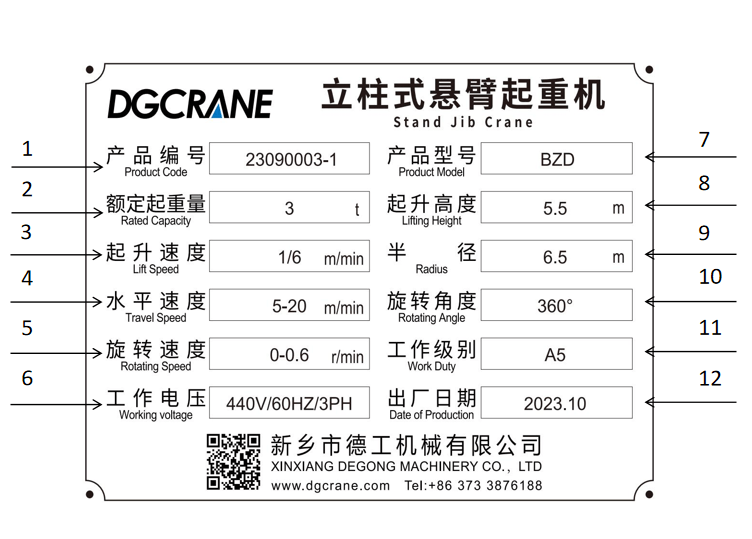
1. Product Number Code:
Assigned by the manufacturer at the time of production, the product code is unique. The manufacturer can use this number to access all information about the product.
2. Rated Capacity:
The maximum weight that the jib crane is allowed to lift in a single operation under normal working conditions, measured in tons (t) or kilograms (kg).
Notes on rated lifting capacity:
A. The rated lifting capacity of a hook crane does not include the weight of the hook and the moving pulley group.
B. The weight of detachable material handling devices like grabs and electromagnetic suction cups should be included in the rated lifting capacity.
C. For variable-radius boom-type cranes, the rated lifting capacity varies with the working radius.
3. Lift Speed:
Refers to the vertical displacement speed of the rated load under stable operating conditions, measured in meters per minute (m/min).
For example, a nameplate indicating 1/6m/min means the jib crane has two lifting speeds: a fast speed of 6m/min and a slow speed of 1m/min.
4. Travel Speed:
Refers to the movement speed of the rated load along the boom in the horizontal direction under stable motion conditions.
A nameplate indicating 5-20m/min means the jib crane’s horizontal speed is variable frequency controlled, ranging from 5 to 20 meters per minute.
5. Rotating Speed:
Refers to the rotational speed of the crane around its pivot point under stable motion conditions. A nameplate indicating 0-0.6r/min means the jib crane’s rotation speed is variable frequency controlled, ranging from 0 to 0.6 revolutions per minute.
6. Working Voltage:
440V refers to the rated voltage, which is the optimal voltage for long-term operation of electrical devices.
60HZ refers to the rated frequency, which is the number of cycles per second allowed in an alternating current circuit.
3PH = 3 phase = Three-phase electrical power.
7. Product Model:
Different models of jib cranes correspond to different model codes.
8. Lifting Height:
The vertical distance from the ground to the highest allowable position of the lifting gear, marked as H. If the crane hook can descend below ground level, the height below ground is called the descending depth (h).
9. Radius:
The slewing radius of the jib equals the effective working radius. Note: Slewing radius and arm length are two different concepts; slewing radius is the distance from the pivot center of the arm to its furthest point, while arm length refers to the length of the arm itself.
10. Rotating Angle:
A rotation angle of 360° indicates that the pillar-type jib crane can move within a 360° range.
11. Work Duty:
The overall working class of the stand jib crane ranges from A1 to A8 (A1 < A8). Other mechanisms, structural components, or mechanical parts have working classes from M1 to M8 (M1 < M8). The working class of a jib crane is determined by two factors: the frequency of use, known as the crane utilization class, and the size of the load it bears, known as the load state of the crane.
12. Date Of Production
Crane Trolley Nameplate
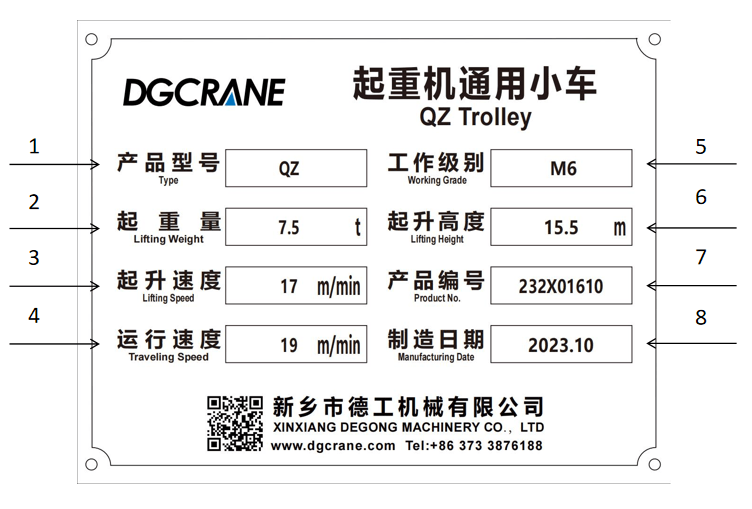
1. Type:
The model code of the crane’s trolley is consistent with the overall model code of the crane.
2. Lifting Weight:
The maximum weight allowed to be lifted in a single operation under normal working conditions, measured in tons (t) or kilograms (kg).
3. Lifting Speed:
Refers to the vertical displacement speed of the rated load on the trolley under stable operating conditions, measured in meters per minute (m/min).
4. Traveling Speed:
The travel speed of the trolley on horizontal tracks under stable motion conditions with the rated load, measured in meters per minute (m/min).
5. Working Grade:
The working class of crane components ranges from M1 to M8 (M1 < M8). The class level is determined by two factors: the frequency of use, known as the utilization class, and the size of the load it bears, known as the load state.
6. Lifting Height:
The vertical distance from the ground to the highest allowable position of the lifting gear, marked as H.
7. Product Number:
Unique number assigned by the manufacturer when the product leaves the factory. The manufacturer can use this number to access all information about the product.
8.Manufacturing Date
Crane Hoist Nameplate
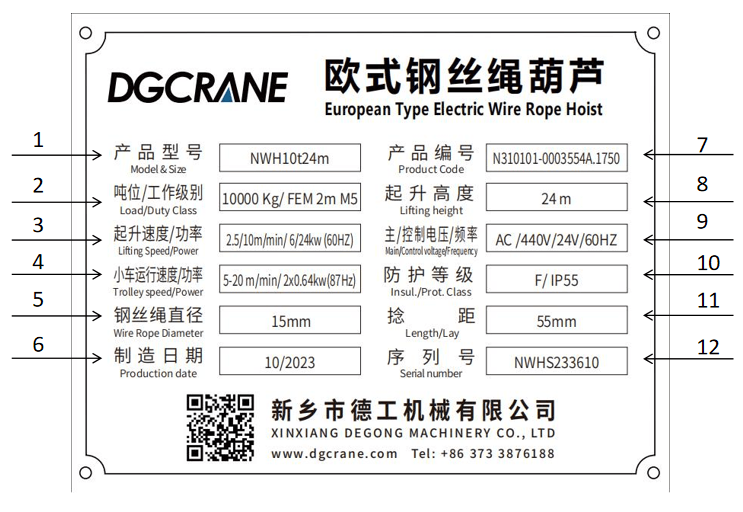
1. Model & Size:
The product model generally consists of three parameters: product identification number, lifting capacity, and lifting height.
Some crane hoists have product identification numbers uniquely set by the manufacturer, which can vary depending on the manufacturer.
2. Load/Duty Class:
10000Kg – Lifting Capacity: The maximum weight allowed to be lifted in a single operation under normal working conditions, measured in tons (t) or kilograms (kg).
FEM 2m=ISO M5 refers to the working class of the crane hoist:
The working class of crane components ranges from M1 to M8 (M1 < M8).
The level of the crane hoist’s working class is determined by two capabilities: the frequency of use, known as the hoist utilization class, and the size of the load it bears, known as the hoist’s load state.
3. Lifting Speed/Power:
Lifting speed refers to the vertical displacement speed of the rated load on the crane hoist under stable operating conditions, measured in meters per minute (m/min). 2.5/10m/min indicates the crane hoist has two lifting speeds: a fast speed of 10m/min and a slow speed of 2.5m/min.
Lifting power refers to the work done by the crane hoist’s lifting motor per unit of time, usually expressed in watts (W) or kilowatts (kW). The power of the crane hoist motor directly affects its operating efficiency and working capacity. 6/24Kw indicates the crane hoist has two power levels: one of 6Kw and another of 24Kw.
60HZ refers to the rated frequency of the hoist’s lifting motor, which is the number of cycles per second allowed in an alternating current circuit.
4. Trolley Speed/Power:
Trolley travel speed refers to the displacement speed of the crane hoist along a specific track under stable operating conditions, measured in meters per minute (m/min). 5-20m/min indicates the trolley’s travel speed is variable frequency controlled, ranging from 5m/min to 20m/min.
Trolley travel power refers to the work done by the hoist’s travel motor per unit of time, usually expressed in watts (W) or kilowatts (kW). The power of the motor directly affects its operating efficiency and working capacity. 2×0.64Kw indicates two 0.64Kw motors operating in parallel, with a total power of 1.28Kw.
87HZ refers to the rated frequency of the hoist trolley’s travel motor.
5. Wire Rope Diameter:
The diameter of the steel wire rope refers to the diameter of its outer circumference.
6. Production Date
7. Product Code:
Unique number assigned by the manufacturer when the product leaves the factory. The manufacturer can use this number to access all information about the product.
8. Lifting Height:
The vertical distance from the ground to the highest allowable position of the lifting gear, marked as H.
9. Main/Control Voltage/Frequency:
AC/440V/24V/60HZ
AC stands for Alternating Current, which refers to an electrical current whose magnitude and direction vary cyclically, averaging zero over one cycle.
440V/24V refers to the rated voltage, which is the optimal voltage for long-term operation of electrical devices. The hoist has two rated voltages: 440V for high speed and 24V for low speed.
60HZ refers to the rated frequency of the hoist’s lifting motor.
10. Insulation/Protection Class:
F refers to the insulation class of the electric hoist motor, indicating the heat resistance grade of its insulation material, categorized as A, E, B, F, H.
Motor protection class is indicated as IPXX, where IP stands for Ingress Protection. The first digit after IP indicates the level of dust protection, ranging from 0 to 5, with higher numbers indicating better dust protection. The second digit indicates the level of water protection, ranging from 0 to 8, with higher numbers indicating better water protection.
11. Lay Length:
The lay length of the steel wire rope is the distance advanced when a strand rotates 360 degrees around the rope core.
12. Serial Number:
Assigned by the manufacturer at the time of production.
Explosion-Proof Hoist Nameplate
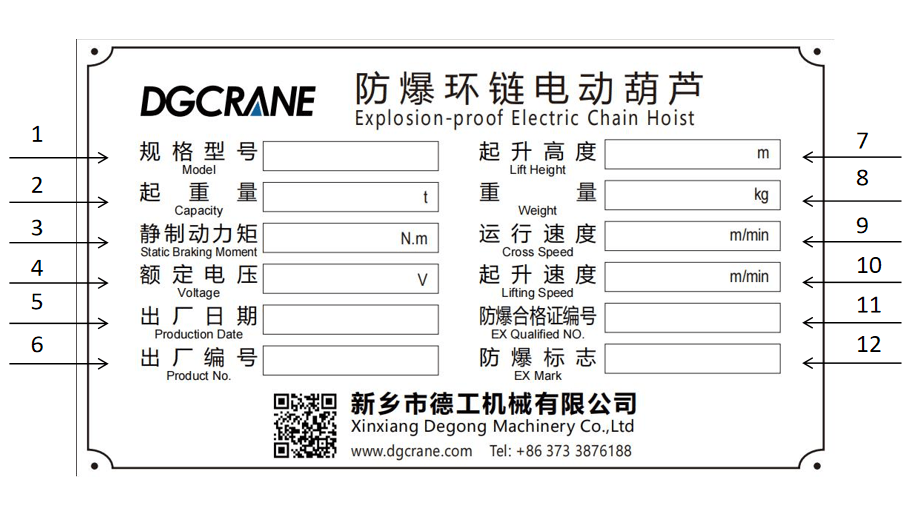
1. Model:
Different types of products correspond to different model codes.
2. Lifting Capacity:
The maximum weight allowed to be lifted in a single operation under normal working conditions, measured in tons (t) or kilograms (kg).
3. Static Braking Moment:
For explosion-proof hoists, the static braking torque refers to the ability of the hoist (or hoist system) to remain stationary or avoid self-rotation without the application of external force or torque. Static braking torque helps ensure that the equipment remains stable when stopped or while carrying a load, reducing the risk of accidents.
4. Rated Voltage:
The rated voltage is the optimal voltage for long-term operation of electrical devices and refers to the voltage at which the device normally operates.
5. Production Date
6. Product Number:
Unique number assigned by the manufacturer when the product leaves the factory. The manufacturer can use this number to access all information about the product.
7. Lifting Height:
The vertical distance from the ground to the highest allowable position of the lifting gear, marked as H.
8. Weight:
The weight of the crane hoist itself.
9. Cross Speed:
The travel speed refers to the displacement speed of the crane hoist along a specific track under stable operating conditions, measured in meters per minute (m/min).
10. Lifting Speed:
Lifting speed refers to the vertical displacement speed of the rated load on the crane hoist under stable operating conditions, measured in meters per minute (m/min).
11. Explosion-Proof Certification Number:
Explosion-proof hoists require a corresponding manufacturing license for production, and each manufacturer has a distinct manufacturing license number.
12. Explosion-Proof Mark:
Common explosion proof marking include ExdIIBT4, ExdIICT4, etc. ‘Ex’ signifies an explosion-proof hoist, ‘d’ indicates that the hoist is flameproof, ‘IIB’ or ‘IIC’ denotes the explosion-proof grade in explosive gas atmospheres, and ‘T4’ represents the maximum working temperature.
Winch Nameplate
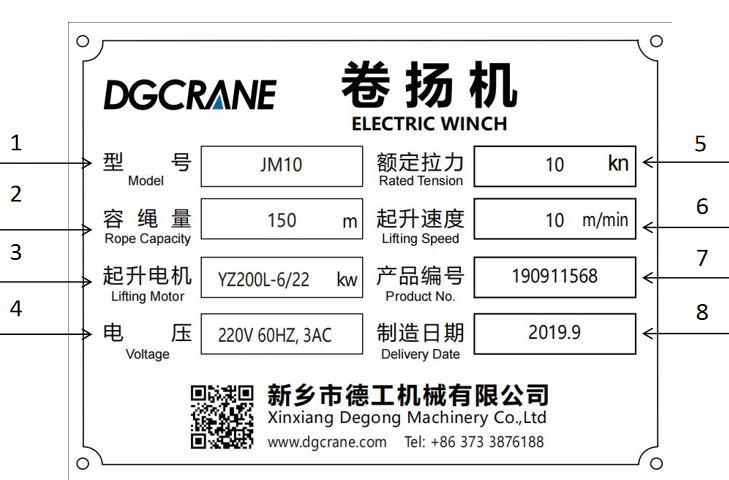
1. Model:
The model of a winch is composed of two parameters: the product identification number and the rated pulling force.
2. Rope Capacity:
The maximum working length of steel wire rope that the drum can accommodate, measured in meters (m).
3. Lifting Motor:
YZ200L-6: Model of the motor.
22Kw refers to the lifting power, which is the work done by the lifting motor per unit of time, typically expressed in watts (W) or kilowatts (kW). The power of the motor directly affects its operating efficiency and working capacity.
4. Voltage:
220V refers to the rated voltage, which is the optimal voltage for long-term operation of electrical devices and the voltage at which the device normally operates.
60HZ refers to the rated frequency, which is the number of cycles per second allowed in an alternating current circuit.
AC stands for Alternating Current, which is an electrical current whose strength and direction vary cyclically, averaging zero over one cycle.
3AC indicates three-phase alternating current.
5. Rated Tension:
The rated pulling force refers to the maximum static pulling force that the outermost layer of the steel wire rope on the drum is allowed to withstand during operation. It represents the working capacity of the winch, measured in KN.
6. Lifting Speed:
Lifting speed refers to the vertical displacement speed of the rated load on the winch under stable operating conditions, measured in meters per minute (m/min).
7. Product Number:
Unique number assigned by the manufacturer when the product leaves the factory. The manufacturer can use this number to access all information about the product.
8. Delivery Date
Crane Control Cabinet Nameplate
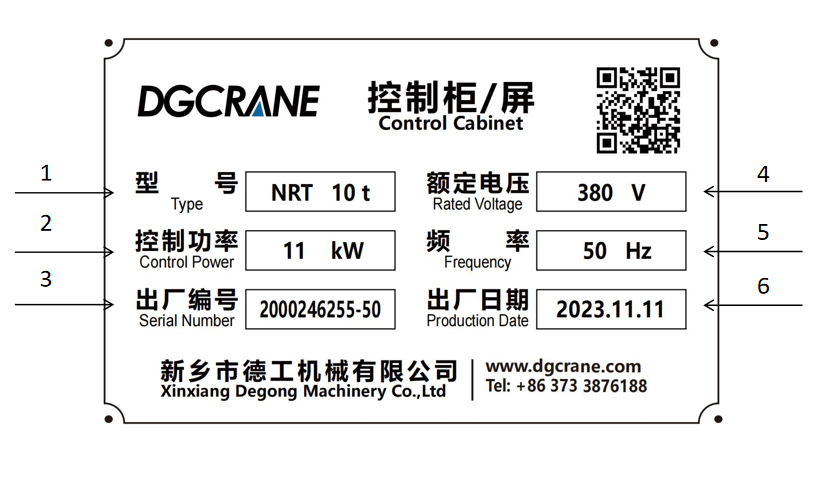
1. Type:
The model of a crane control cabinet is typically composed of two parameters: an identification number and the crane’s rated lifting capacity. The identification number is usually named by the manufacturer and can vary between manufacturers. The model often reflects the specific functions, specifications, or applications of the control cabinet.
2. Control Power:
The control power of a crane control cabinet refers to the power used to control and operate the crane’s electrical equipment. It indicates the electrical load capacity that the internal circuits and components of the control cabinet can handle. The size of the control power is influenced by the type, scale, and design requirements of the crane. Choosing the appropriate control power is crucial for ensuring the safe and efficient operation of the crane. It is usually expressed in watts (W) or kilowatts (kW).
3. Serial Number:
Unique number assigned by the manufacturer when the product leaves the factory. The manufacturer can use this number to access all information about the product.
4. Rated Voltage:
The rated voltage is the optimal voltage for long-term operation of electrical devices and refers to the voltage at which the device normally operates.
5. Frequency:
The rated frequency refers to the number of cycles per second that the alternating current is allowed and required to change in an alternating current circuit.
6. Production Date
Three-Phase Induction Motor Nameplate
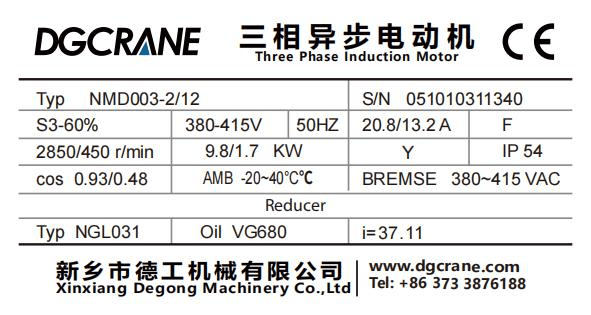
1. Model (NMD003-2/12):
The model of a three-phase asynchronous electric motor is composed of uppercase English letters and Arabic numerals. The model typically includes the product code, design number, specification code, and special environment code.
2. Duty Cycle (S3-60%):
The duty cycle refers to the mode of operation of the motor, i.e., the duration for which the motor runs, and is divided into three types: continuous duty, short-time duty, and intermittent duty.
– Continuous Duty (S1): The motor can operate continuously for an extended period without time limitation, as per the nameplate data, without exceeding the permissible temperature rise.
– Short-Time Duty (S2): The motor can only operate for a specified short duration (starting from cool condition) without exceeding the temperature limit. In China, the specified short-time durations are 15min, 30min, 60min, and 90min.
– Intermittent Duty (S3): The motor operates for a period, then stops for a period, repeating in a specific cycle. The ratio of load operation time to the total cycle is called the “duty cycle (intermittent rate).” In China, the specified duty cycles are 15%, 25%, 40%, 60%, with each cycle being 10 minutes. The nameplate in figure 2 indicates a duty cycle of “S3,” meaning the motor operates 60% of the time in a 10-minute cycle and stops 40% of the time.
3. Rated Speed (2850/450r/min):
The rated speed is the speed at which the motor operates under rated conditions, measured in revolutions per minute (r/min).
4. Rated Power Factor (cos 0.93/0.48):
Rated Power Factor (cosN): As an electric motor is an inductive load, the stator phase current lags behind the phase voltage, and cos is the power factor of the asynchronous motor.
5. Rated Voltage (380V-415V):
Rated voltage refers to the line voltage specified for the stator winding when the motor operates under rated working conditions, measured in volts (V) or kilovolts (KV).
6. Rated Frequency (50HZ):
Rated frequency is the frequency of the power supply applied to the stator winding of the motor when operating under rated conditions, i.e., the frequency of the alternating current supplied to the motor, measured in hertz (Hz). The nameplate in figure 2 shows a rated frequency of 50Hz.
7. Rated Power (9.8/1.7KW):
Rated power is the mechanical efficiency output on the shaft of the motor when operating under rated working conditions, measured in watts (W) or kilowatts (KW).
8. Operating Temperature Range (-20°~40°)
9. Serial Number (S/N 051010311340):
Assigned by the manufacturer at the time of production.
10. Rated Current (20.8/13.2A):
Rated current refers to the line current input to the stator winding of the motor when operating under rated conditions, measured in amperes (A) or kiloamperes (KA). If two current values appear on the nameplate, it indicates the stator winding’s input line current for two different connection methods (e.g., delta and star connection).
11. Insulation Class (F):
Insulation class is categorized based on the heat resistance of the insulation materials used in the motor. Different insulation materials have different insulation classes, and different insulation classes have different maximum operating temperatures. The insulation class “F” on the nameplate in figure 2 indicates a permissible temperature of 155°C for the insulation material and a permissible temperature rise of 100°C for the motor.
12. Motor Windings (Y):
Motor windings are indicated by uppercase letters, such as A, B, C, U, V, W, X, Y, Z.
13. Protection Class (IP54):
The protection class of the motor enclosure is composed of the letters “IP” and two Arabic numerals. “IP” is the abbreviation for International Protection. The first digit after “IP” represents the level of dust protection (0 to 6 levels), and the second digit represents the level of water protection (0 to 8 levels). Higher numbers indicate a higher level of protection.
14. Rated Voltage (380~415VAC):
AC stands for Alternating Current, and 380V~415V is the rated voltage.
15. Reducer:
– (1) Model (NGL031)
– (2) Lubricant Grade (Oil VG680)
– (3) Gear Ratio (i=37.11)
Explosion-Proof Three-Phase Induction Motor Nameplate

1. Model:
For example: YB3-132 S2-2
Y refers to “Asynchronous Motor”
B indicates “Explosion-Proof”
3 represents “Third Design Version”
132 refers to “Center Height of the Frame”
S2 denotes “Frame Length Code”
2 indicates “Number of Poles”
2. Rated Rotation:
The rated speed refers to the speed at which the motor operates under rated conditions, measured in revolutions per minute (r/min).
3. Rated Current:
Rated current refers to the line current input to the stator winding of the motor when operating under rated conditions, measured in amperes (A) or kiloamperes (KA).
4. Rated Frequency:
Rated frequency is the frequency of the power supply applied to the stator winding of the motor when operating under rated conditions, i.e., the frequency of the current supplied to the motor, measured in hertz (Hz).
5. Rated Power:
Rated power is the mechanical efficiency output on the shaft of the motor when operating under rated working conditions, measured in watts (W) or kilowatts (KW).
6. Explosion-Proof Certification Number:
Explosion-proof motors require a corresponding manufacturing license for production, and each manufacturer has a distinct manufacturing license number.
7. Rated Voltage:
Rated voltage refers to the line voltage specified for the stator winding when the motor operates under rated working conditions, measured in volts (V) or kilovolts (KV).
8. Noise Limit:
Different types of motors have different noise limits.
9. Static Braking Moment:
Static braking torque refers to the ability of the motor to remain stationary or avoid self-rotation without the application of external force or torque. Static braking torque helps ensure that the equipment remains stable when stopped or while carrying a load, reducing the risk of accidents.
10. Explosion-Proof Mark:
Common explosion proof symbol include ExdIIBT4, ExdIICT4, etc. ‘Ex’ signifies an explosion-proof hoist, ‘d’ indicates that the hoist is flameproof, ‘IIB’ or ‘IIC’ denotes the explosion-proof grade in explosive gas atmospheres, and ‘T4’ represents the maximum working temperature.
11. Product Number:
Unique number assigned by the manufacturer when the product leaves the factory. The manufacturer can use this number to access all information about the product.
12. Production Date
Crane Cable Reel Nameplate
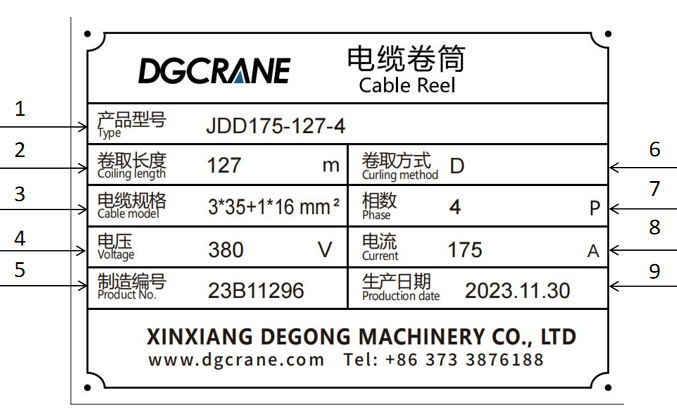
1. Type:
The product model of a cable reel typically consists of four parameters: product identification number, rated current, winding length, and the number of cables. The product identification number is usually customized by the manufacturer based on the customer’s actual usage scenario and product catalog.
2. Coiling Length:
The length of the cable that can be wound onto the reel.
3. Cable Model:
“3*35+1*16” represents a four-core cable comprising three 35 square millimeter conductors and one 16 square millimeter conductor, which is a three-phase, four-wire system.
4. Voltage:
Rated voltage refers to the line voltage specified for the stator winding of a motor when operating under rated working conditions, measured in volts (V) or kilo volts (KV).
5. Product Number:
Unique number assigned by the manufacturer when the product leaves the factory. The manufacturer can use this number to access all information about the product.
6. Curling Method:
Regarding the winding method of a cable reel, “D” usually refers to “Direct,” meaning the cable is wound directly onto the reel without passing through any guiding or leading device.
7. Phase:
Phase count refers to the number of cable wires.
8. Current:
Rated current refers to the current of an electrical device operating at its rated power under rated voltage. It can also be defined as the current that electrical equipment can continuously work with under rated environmental conditions. The current during normal operation of an appliance should not exceed its rated current.
9. Production Date
Crane Drum Nameplate
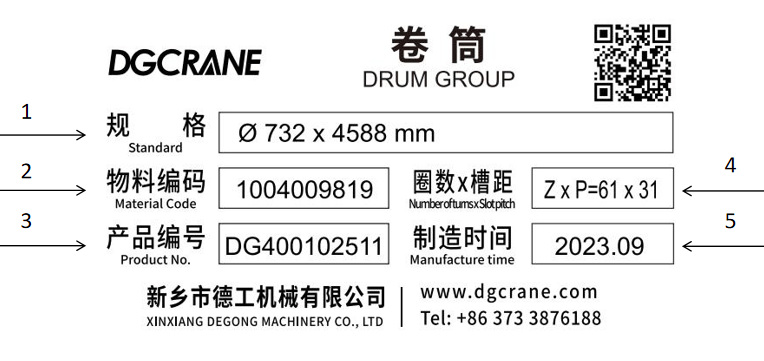
1. Standard:
– ø (Diameter): Here, “ø732” indicates that the diameter of the drum is 732 millimeters.
– 4588mm: This number represents the length of the drum, which is 4588 millimeters.
2. Material Code:
The material code of a drum is a unique code assigned by the manufacturer or supplier for identifying and tracking their product. This code can vary among manufacturers, as different companies may use different coding systems. The material code usually includes various information about the product, such as dimensions, materials, features, etc.
3. Product Number:
Unique number assigned by the manufacturer when the product leaves the factory. The manufacturer can use this number to access all information about the product.
4. Number Of Turns x Slot Pitch:
– Turns: The number of rope grooves (helical grooves) on the drum.
– Pitch: The horizontal distance between the centers or corresponding edges of two rope grooves.
5. Manufacture Time
Crane Rail Clamp Nameplate
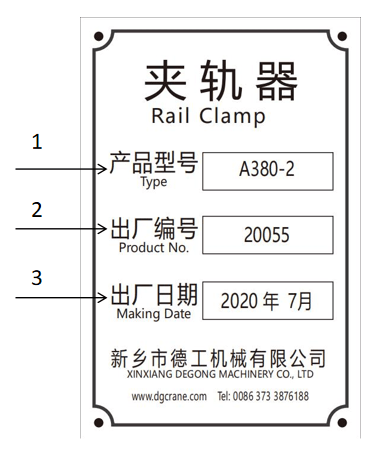
1. Type:
Different types of crane rail clamps correspond to different product models. A380-2 is a model of a manual rail clamp.
The product model of a rail clamp is composed of two parameters: the handwheel diameter and the design sequence.
2. Product Number:
The product number is assigned by the manufacturer at the time of production. It is unique, and the manufacturer can retrieve all information about the product through this device code.
3. Making Date
Crane Hook Nameplate

1. Product Name
2. Load Capacity:
The load capacity of a hook refers to its rated lifting capacity, which is the maximum mass allowed for a single lift under normal working conditions. It is measured in tons (t) or kilograms (kg).
3. Date of Manufacture
4. Self-Weight:
The self-weight of a C-type crane hook.
5. Product Code:
The product number is assigned by the manufacturer at the time of production. It is unique, and the manufacturer can access all information about the product through this device code.
Crane Reducer Nameplate
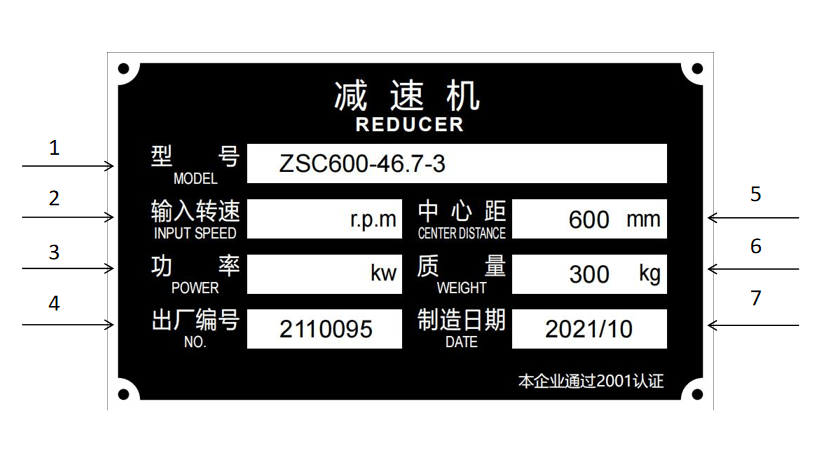
1. Model:
The model of a reducer typically comprises four parameters: the code, center distance, transmission ratio, and assembly type.
The code of a reducer is usually named by the manufacturer and may vary from one manufacturer to another. This code often reflects the reducer‘s specific functions, specifications, or applications.
600mm is the center distance of the reducer: Also known as the center height, it represents the height from the center of the output shaft to the base. Its main purpose is to provide precise positioning during the installation of the reducer.
46.7 is the transmission ratio of the reducer: This is the speed ratio of the reducer, indicating the ratio of the instantaneous input speed to the output speed, denoted by the symbol “i”. It represents the ratio of rotational speeds between the input and output shafts.
3 refers to the assembly type, i.e., the arrangement of the high-speed and low-speed shafts of the reducer.
2. Input Speed:
The rated speed of the electric motor, measured in revolutions per minute (r/min or RPM).
3. Power:
Rated power refers to the mechanical efficiency that can be output on the shaft of the reducer when operating under rated conditions. It is measured in watts (W) or kilowatts (KW).
4. Factory Number:
The product number is assigned by the manufacturer at the time of production. It is unique, and the manufacturer can access all information about the product through this device code.
5. Center Distance:
The center distance of the reducer: Also known as the center height, it represents the height from the center of the output shaft to the base. Its main purpose is to provide precise positioning during the installation of the reducer.
6. Weight:
The self-weight of the gearbox.
7.Manufacturing Date
Crane Brake Nameplate
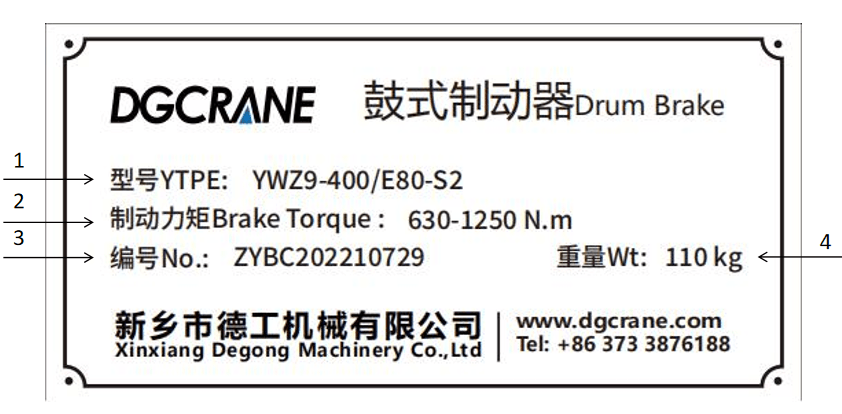
1. Type:
The model of a crane brake typically consists of four parameters: the series code, brake wheel diameter, actuator code, and a code for additional features of the crane drum brake.
YWZ9 – Series code
400 – Brake wheel diameter (in mm)
E80 – Actuator code (For Ed actuator, the code is E; YT1 actuator is not marked)
S2 – Code for additional features of the crane brake
2. Braking Torque:
The braking torque of a crane brake refers to the torque or force moment generated by the brake during braking. In industrial applications like cranes, brakes are commonly used for decelerating and stopping equipment. The braking torque can be adjusted within the range of 630-1250 N.m.
3. Number:
The product number is assigned by the manufacturer at the time of production. It is unique, and the manufacturer can access all information about the product through this device code.
4. Weight:
The self-weight of the brake.
Crane Load Limiter Nameplate
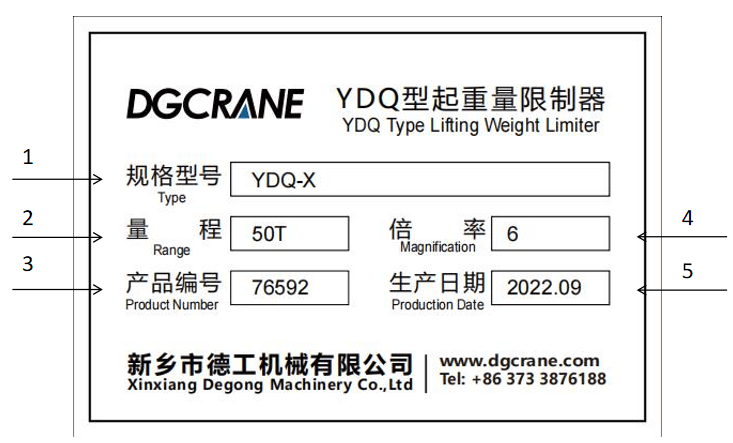
1. Type:
2. Range:
Refers to the maximum load that the sensor of the load limiter for lifting equipment can withstand.
3. Product Number:
The product number is assigned by the manufacturer at the time of production. It is unique, and the manufacturer can access all information about the product through this device code.
4.Magnification:
The force multiplication factor of the pulley block of a crane or tower crane. It is the ratio of the number of flexible elements (e.g., ropes) passing through the hook pulley block to the number of flexible elements entering the drum (or chain).
5. Production Date














































